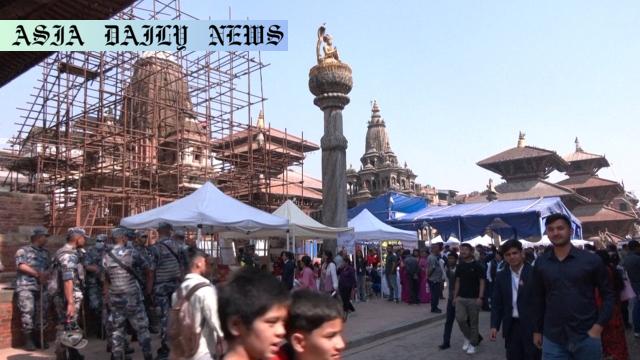Earthquake: Nepal reflects on 10 years since the devastating 7.8 magnitude earthquake that caused immense fatalities and destruction.
- The 2015 magnitude 7.8 earthquake killed an estimated 9,000 people.
- About 900,000 buildings were damaged, accounting for 20% of Nepal’s infrastructure.
- On the 10th anniversary, ceremonies and prayers were held near Kathmandu.
- Reconstruction is progressing, though rural areas still face challenges with quake resistance.

Reflecting on the Tragedy of Nepal’s 2015 Earthquake
Nepal commemorates a grim milestone: the tenth anniversary of the devastating 7.8 magnitude earthquake that shook the nation on April 25, 2015. The catastrophe resulted in the loss of approximately 9,000 lives and inflicted massive destruction on the country’s infrastructure, with around 900,000 buildings damaged or destroyed. This tragedy highlighted the vulnerability of densely populated areas and rural communities alike, revealing weaknesses in preparedness, structural integrity, and disaster management systems.
As time has passed, Nepalese citizens and authorities have worked together to rebuild and recover. While significant progress has been made to restore infrastructure and services, many areas, particularly in rural regions, continue to face challenges. Simple earthen and brick structures, common outside urban centers, remain vulnerable to potential future seismic activity. This underscores the vital need for better education on earthquake preparedness and investment in quake-resistant housing and urban planning.
Paying Tribute and Learning from the Past
This year’s memorial ceremonies were deeply poignant. Organized by the Nepali government, they brought together approximately 3,000 individuals, including military personnel, police officers involved in rescue missions, and families who lost loved ones. A moment of silence was observed, followed by the offering of prayers and flowers. Such events not only honor the victims but also emphasize the need for collective remembrance and lessons learned from this dark chapter of Nepal’s history.
A bereaved grandmother, who lost her two grandchildren during the disaster, shared her heartfelt message. She expressed her hope that such a tragedy would never happen again, emphasizing the importance of increasing preparedness for future earthquakes. Her words resonate strongly, serving as a reminder of the resilience and determination of Nepali people to face and overcome adversity.
Advancing Rebuilding Efforts Despite Challenges
Over the past decade, the reconstruction of homes, schools, and critical infrastructure has gained momentum. Urban centers like Kathmandu have seen extensive rebuilding efforts, often supported by international aid. Many historical landmarks, vital for tourism and cultural heritage, have also been restored to their former glory. These initiatives highlight the determination and resilience of Nepal as it seeks to move forward from the tragedy.
However, significant challenges persist, particularly in rural regions. Limited access to resources and economic constraints have hindered the ability to construct earthquake-resistant buildings. As a result, future seismic events could pose a renewed threat. By prioritizing education, government collaboration, and international assistance, Nepal hopes to mitigate these risks and protect its population better in the years to come.
The Path Forward: Preparedness and Community Resilience
Looking ahead, Nepal continues to focus on improving disaster preparedness and response. Public awareness campaigns, seismic safety training, and updated building codes have been introduced to enhance resilience at multiple levels. Moreover, community-based initiatives are being promoted as a way to ensure that local populations are actively involved in making their environment safer.
While the scars of the 2015 earthquake will never fully heal, they serve as a lasting reminder of the importance of preparedness, proper urban planning, and resilience-building measures. By learning from the past and investing in the future, Nepal is taking steady steps toward minimizing the catastrophic impacts that such natural disasters can cause.



Commentary
The Legacy of Nepal’s 2015 Earthquake
Reflecting on the 10th anniversary of Nepal’s catastrophic earthquake evokes a mix of sorrow and inspiration. The earthquake not only claimed thousands of lives but also left an indelible mark on the nation’s physical and emotional landscape. Yet amid the devastation, the resilience and strength demonstrated by the Nepali people have been remarkable.
The sight of families remembering loved ones during memorial ceremonies is a profound reminder of the human cost of natural disasters. It is heartbreaking to think of the immense loss of life, particularly among children and vulnerable members of society. Yet, the unity and determination displayed by the nation in the aftermath of this tragedy provide a glimmer of hope. Efforts to rebuild, coupled with renewed emphasis on preparedness, underscore the spirit of a community determined to rise above adversity.
The Importance of Earthquake Preparedness
This anniversary serves as a call to action for countries worldwide, particularly those situated along tectonic fault lines. Nepal’s tragedy is a stark reminder of the importance of investing in infrastructure, education, and early warning systems. Earthquakes, though unpredictable, demand a proactive attitude—one that involves governments, international partners, and local communities working together to mitigate risks.
The building of quake-resistant structures and the reinforcement of crucial public infrastructure are of utmost importance. Yet, these efforts must extend beyond construction to include public awareness campaigns and education on seismic safety. Empowering communities with knowledge can save countless lives when disasters strike.
A Global Lesson in Resilience
Reflecting on Nepal’s journey over the past decade highlights the resilience of humanity in the face of overwhelming challenges. While there is still much to be done, the progress achieved so far is commendable. For other nations, Nepal’s experience serves as both a cautionary tale and a source of inspiration—a reminder that even in the wake of despair, progress and recovery are possible.
As the international community observes Nepal’s ongoing efforts, there is an opportunity to offer support—not just financially but also through the sharing of technology and expertise. Together, we can help ensure that when natural disasters strike, their impacts on human lives and societies are minimized.